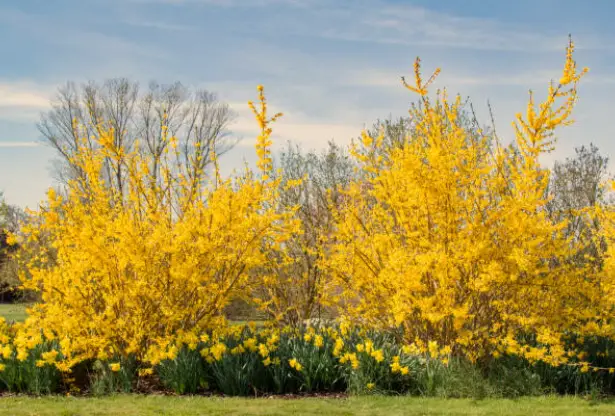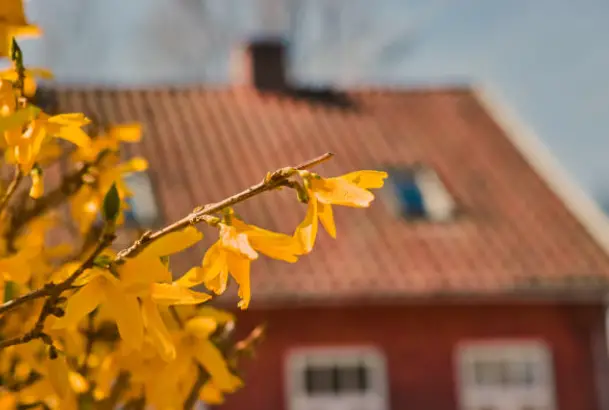Few flowering shrubs herald the arrival of spring quite like the forsythia. As winter’s icy grip starts to loosen, those brilliant yellow blossoms seem to arrive almost overnight, painting the landscape with their sunny warmth and cheer.
A member of the olive family, forsythias are hardy, long-lived shrubs that ask very little in terms of maintenance, yet deliver an incredibly vibrant display year after year.
If you’re fortunate enough to have a forsythia gracing your yard, you’ll want to take just a few simple steps to ensure it remains a radiant showstopper for decades to come.
With the proper pruning, fertilization, and care, these bushes are capable of flowering profusely for 50 years or more. Let’s dive into everything you need to know to keep your forsythia looking its dazzling best.
Forsythia Plant Variety Selection
While all forsythias produce those iconic yellow flowers, they can vary in terms of size, growth habit, and blossom time. This allows you to select the perfect variety for your landscape’s needs.

Forsythia Plant
The two most common species are the Forsythia x intermedia varieties, which produce plentiful blooms on arching branches, and the more upright Forsythia viridissima cultivars, characterized by more sparse but striking flower clusters.
Intermedia types like ‘Lynwood’ and ‘Spectabilis’ will ultimately reach 8-10 feet tall and wide if left unchecked, while viridissima kinds such as ‘Bronxensis’ top out at around 6-8 feet.
For hedges or smaller areas, compact cultivars like ‘Courtasol’ (intermedia) and ‘Bronxensis Dwarf’ (viridissima) make excellent choices, maturing to 3-5 feet in height. There are even bizarre contorted or weeping forms for adding whimsical flair to the garden.
One of the greatest joys of forsythia is its incredibly long bloom period compared to most spring flowers. Early varieties like ‘Spring Glory’ frequently start pushing out blooms in late winter, while late-season types like ‘Meadowlark’ can keep the show going into early May in colder climates. Planting an assortment ensures you can enjoy those cheery yellow blossoms for 6-8 weeks or more.
Planting
Forsythias are robust shrubs that can thrive in most soil types, from sandy to heavy clay.
They prefer a neutral to slightly alkaline soil pH, but can handle somewhat acidic conditions as long as drainage is good. Choose a planting site that receives full sun for best flowering—at least 6 hours of direct light daily.
When planting, dig a hole 2-3 times as wide as the rootball but no deeper. Backfill with a mix of topsoil and compost, planted at the same level as it was previously growing. Apply a 2-4 inch deep mulch layer, keeping it pulled back from the trunk by several inches.
Space multiple forsythias 4-6 feet apart if creating a hedge row. For natural groupings, leave 6-10 feet between plants to allow for their mature spread. Water thoroughly after planting and continue watering regularly in the following weeks to help them establish. An occasional deep soaking is better than light daily watering.
Pruning
The magic of forsythia is that it blooms on old wood, meaning the flower buds form on stems produced the previous growing season. Improper pruning at the wrong time of year can easily remove next spring’s floral display!
Timing is critical. Never prune forsythia in fall, winter, or early spring before flowering is finished for the season. You want to enjoy those gorgeous blossoms on the older branches first. Instead, do any shaping immediately after the bush is done blooming in late spring. At this point, the flower buds for next year have yet to form.
To prune, first remove any dead, damaged, or rubbing branches from the interior. This opens up the shrub to better air circulation and light penetration. You can also thin out older branches from the base to gradually rejuvenate the plant over time.
For size control on larger forsythias, use heading cuts immediately after flowering to shorten overly long shoots back to an outward-facing bud or branch. Remove no more than 1/4 to 1/3 of the oldest stems each year and your forsythia will quickly become remarkably more compact while still flowering heavily.
Hedges can be lightly sheared right after blooming finishes to maintain a tidy appearance. But take care not to cut back too far into the interior woody stems—you may remove most of next season’s flower buds!
Fertilization
Forsythias are not particularly heavy feeders, but will benefit from an annual application of a balanced fertilizer to maintain vigor.
For established bushes over 3 years old, spread 1 cup of balanced 10-10-10 fertilizer per plant around the drip line in early spring, just before flowering begins. Gently scratch it in to the top few inches of soil, then water thoroughly. A 2-4 inch mulch layer replenished annually also provides important nutrients as it decomposes.
Younger forsythias can use a little extra help while getting established. Apply a balanced granular fertilizer monthly through the first growing season, switching to the single springtime feeding thereafter.
If growth seems stunted or foliage appears pale despite adequate water, try an acidifying fertilizer formulated for evergreens and azaleas. This can help raise iron availability in high pH soils where chlorosis may be an issue.
Water and Mulch
Forsythias are wonderfully drought-tolerant once established, a trait that contributes to their longevity. However, consistent moisture results in better flowering and growth—especially when newly planted.
The first year after installation, apply at least 1 inch of water weekly to forsythias during the growing season, either from rainfall or manual watering. In hot, dry conditions, they’ll need even more. Use a soaker hose and avoid overhead watering to minimize potential disease issues.
Once the extensive root system develops over 2-3 years, forsythias can handle typical rainfall without supplemental irrigation in most climates. Only in extended drought will they need a restorative deep soak.
A 3-4 inch layer of organic mulch like woodchips, leaves, or bark is invaluable for conserving soil moisture and keeping roots cool in summer. Replenish this protective layer as it decomposes annually to continue reaping the benefits.
Potential Concerns
Despite their durability, forsythias can sometimes fall victim to disease, pests, or winter injury. Keeping plants healthy, avoiding excess nitrogen fertilizer, and providing good air circulation helps prevent most issues.
Fungal diseases like blight and leaf spot can sporadically appear but rarely cause lasting harm. Prune out affected areas and avoid overhead irrigation to manage these foliar problems.
Forsythia is a favorite food source for certain insects like the dreaded viburnum leaf beetle. The beetle larvae can quickly defoliate entire branches if left unchecked. While unsightly, the plant will recover the following year. Insecticidal soap and horticultural oil provide safe organic controls.
Winter cold can damage young forsythia branches, particularly in exposed sites at the northern edge of their hardiness range. Mulching well and keeping plants watered prior to hard freezes provides insulative protection for roots and crowns. New spring growth will eventually fill any bare patches.
With their strong resilience, forsythias have a remarkable ability to brush off most setbacks with ease. Their quick, dense growth self-repairs nicely from even severe pruning gaffes or pest damage.
Final Tips
Follow these additional pointers for maximum forsythia splendor:
– To force forsythia branches for indoor bloom, trim and soak stems in warm water while still dormant in late winter, providing bottom heat.
– Consider planting forsythia where you can appreciate its cheerful branches arching over pathways or spilling across slopes.
– Keep an eye out for the less common forsythia cultivars like the pale ‘Golden Peep’ or burgundy-stemmed ‘Satina’ for added intrigue.
– Cut a handful of blooming forsythia stems annually for beautiful bouquets to brighten your home in early spring.
With their rugged hardiness, vibrant color and gracefully arching form, forsythias are a classic flowering shrub that no garden should be without. Give them a sunny spot with decent soil and a bit of annual pruning, and they’ll punctuate the end of winter with incredible brilliance year after year. Let the bright yellow blooms of forsythia be the spark that kindles your spring gardening spirit!




